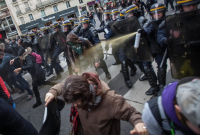Support strong Canadian climate journalism for 2025
When did our community policing culture shift from one of assistance to perceived intimidation, and where did our honoured, approachable peace officers go?
Are we following the footsteps of US police forces, which are armed with riot gear, armoured vehicles and other military-grade equipment?
Having built my life as a design professional in the field of visual culture over the past 20 years, I have to ask what purpose is served by the recent shift in police vehicle design in cities across Canada.
Toronto police cruisers are getting a drastic make-over, from white with bright red and blue decals, to stealth-like dark grey colours with equally somber decals that blend into the paint. Calgary recently switched its police vehicles to what’s been called “aggressive” and “paramilitary” black and white.

And Vancouver unveiled black, stealth-like vehicles back in 2013.

Did the design briefs state and call for oppressive, aggressive, intimidating and combative traits?
That’s what these designs convey.
Design forms our visual culture and creates reality
We need to be more mindful and aware. Design forms our visual culture, which forms perception and ultimately creates our reality.
There’s a real connection between the use of colours and perceptions. For instance, grey is the colour of detachment, indecision and compromise. The closer grey fades to black, the more dramatic and mysterious it becomes.
Many countries in Europe, as well as Australia, New Zealand and Hong Kong, have used bright, colourful Battenburg Markings for decades to gain visibility.

The purpose of this universal language of assistance is to:
- Enhance officer and public safety by reducing the likelihood of road accidents
- Be recognizable as a police vehicle up to a distance of 1,600 ft. in normal daylight
- Assist in high visibility policing to reassure the public and enhance potential deterrent benefits.
Fortunately, the RCMP, internationally known for its scarlet red uniforms, has maintained vivid colour schemes. It suggests RCMP officers are not lurking in the shadows waiting to get you. They’re out in the open, there to help.
So where’s this antagonistic ‘design of darkness’ coming from? Is it a reflection of our police forces’ internal psychology and culture?
It shouldn’t be. Not even close.
Canada is among the most peaceful nations in the world, welcoming and celebrating diverse nationalities and cultures. That’s not just a stereotype of politeness, apologetic kindness and quick smiles, it’s a fact.
Using 23 indicators to gauge ongoing domestic and international conflict, societal safety, security and militarization, the United Nations' Global Peace Index ranks Canada 4th behind Iceland, Denmark and New Zealand.
That’s something to be proud of. And our police culture — how officers show up — needs to reflect who we are as a nation.
Police should be community leaders, not prison guards
We need officers to be community leaders, not prison guards. Police can be a beacon of light and enhance the quality of life for everyone in our communities. They’re integral to our safety, security and well-being.
We need officers on the street engaging community, visiting schools, chatting with students and handing out swag, not scaring the crap out of law-abiding citizens.
There might be a few bad apples we see in the media, but police officers are courageous, responsible individuals with empathy and compassion. They demonstrate integrity and respectful engagement and collaboration with citizens.
I recently had the pleasure of listening to BC RCMP’s Lower Mainland District Commander Bill Fordy speak at a CreativeMornings event, where innovators explore and share ideas. He said he became a police officer “to help people.” He spoke a lot about being trustworthy, transparent, visible and engaging the community.
Those are powerful values, and they reflect who we are as a nation. So instead of being led down the dark and dismal military path, let’s consciously demonstrate and illuminate our radiant values to the world.
Although it’s ‘not Canadian’ to praise ourselves, it’s important to recognize our successes, and periodically pat ourselves on the back.
Policing design should cultivate a safe and inclusive identity
We need to open up public discussions to stop this fear-mongering trend.
Design communities need to provide insight, input and guidance to establish the right meanings and messages. It’s critical on so many levels, from how it impacts our children’s views and behaviours to the type of recruits the police force attracts.
Others will look to us and follow.
Case in point: Los Angeles Police Department recruits are being taught “Canadian values and ideas” during their six-month courses. Yes, we’re teaching our friends to the South critical thinking and concepts like community values.
So let’s be true to ourselves and our values, and have our peace officers connect, collaborate and lead our communities with the right image and visual messages. Let’s cultivate, nurture and shape friendly, vibrant and inclusive communities where we can all be safe, healthy and happy. It’s a true reflection of who we are.
It’s the Canadian way.
Johnathon Vaughn Strebly is Ethics chair and President, Graphic Designers of Canada (GDC)






Comments
Now only are we following along the American way with our police car markings, most of our police officers (including some of our female members) are becoming very similar to the bulky, overweight bulldogs that you see on American TV. Our officceers are no longer the average man or woman on the street. It seems that if you don't weigh over 200 to 250 they won't consider you for city police.
Completely agree with Johnathan's sentiments expressed in his article. I am particularly concerned about how visitors and new Canadians will interpret the new colour schemes. I believe he also makes a good point regarding how it impacts and influences prospective recruits.
I see the Vancouver police cars daily, I actively dislike the dark colour scheme. Let's have a colour scheme that indicates "I am here to assist" not one that shouts out "Here comes the enforcer"
Thank you for writing about this, Johnathon. It it isn't just the menacing vehicles, it is the increasingly hostile military uniforms, plethora of weapons every officer carries, and deteriorating attitudes of officers. Helpful Officer Friendly, with smiles and laid-back attitude has been replaced by militant, cranky, sometimes power-tripping bully types. The skyrocketing rates of beatings and even death they are dishing out is no coincidence. Calgary's menacing cruisers all have big steel cattle guards on the front - for what possible reason? The motto change from Protect and Serve to "Vigilance, Courage, Pride" says it all. Nothing to do with serving or protecting the public, it's now all about their "brotherhood".
Thank you for writing about this, Johnathon. It it isn't just the menacing vehicles, it is the increasingly hostile military uniforms, plethora of weapons every officer carries, and deteriorating attitudes of officers. Helpful Officer Friendly, with smiles and laid-back attitude has been replaced by militant, cranky, sometimes power-tripping bully types. The skyrocketing rates of beatings and even death they are dishing out is no coincidence. Calgary's menacing cruisers all have big steel cattle guards on the front - for what possible reason? The motto change from Protect and Serve to "Vigilance, Courage, Pride" says it all. Nothing to do with serving or protecting the public, it's now all about their "brotherhood" and everyone else assumed to be 'perps'.
“Most of the people in our society are sheep. They are kind, gentle, productive creatures who can only hurt one another by accident.”
I mean nothing negative by calling them sheep. To me it is like the pretty, blue robin’s egg. Inside it is soft and gooey but someday it will grow into something wonderful. But the egg cannot survive without its hard blue shell. Police officers, soldiers, and other warriors are like that shell, and someday the civilization they protect will grow into something wonderful.? For now, though, they need warriors to protect them from the predators.
Then there are the wolves and the wolves feed on the sheep without mercy. Do you believe there are wolves out there who will feed on the flock without mercy? You better believe it. There are evil men in this world and they are capable of evil deeds. The moment you forget that or pretend it is not so, you become a sheep. There is no safety in denial.
Then there are sheepdogs who live to protect the flock and confront the wolf.
If you have no capacity for violence then you are a healthy productive citizen: a sheep. If you have a capacity for violence and no empathy for your fellow citizens then you have defined an aggressive sociopath: a wolf. But what if you have a capacity for violence and a deep love for your fellow citizens? What do you have then? A sheepdog. A warrior. Someone who is walking the hero’s path. Someone who can walk into the heart of darkness, into the universal human phobia, and walk out unscathed.
The sheep generally do not like the sheepdog. He looks a lot like the wolf ("our officers are no longer the average man or woman on the street"). He has fangs ("menacing vehicles, "hostile uniforms," and "a plethora of weapons") and the capacity for violence. The difference, though, is that the sheepdog must not, cannot and will not ever harm the sheep. Any sheepdog who intentionally harms the lowliest little lamb will be punished and removed. The world cannot work any other way, at least not in a representative democracy or a republic such as ours.
Still, the sheepdog disturbs the sheep. He is a constant reminder that there are wolves in the land. They would prefer that he didn’t tell them where to go, or give them traffic tickets, or stand at the ready in our airports in camouflage fatigues holding an M-16. The sheep would much rather have the sheepdog cash in his fangs, spray paint himself white, and go, “Baa” ("It's the Canadian way.").
Until the wolf shows up. Then the entire flock tries desperately to hide behind one lonely sheepdog.
Neither the article nor the comments say anything about not wanting police or military, it is about deliberately projecting an image of menace that is unnecessary and unappreciated by much of the citizenry. When police abuse scandals are in the news daily and lawsuits are resulting in hundreds of millions of taxpayer dollar settlements, it is obviously time to make some changes. The NWMP, later RCMP always got their man despite the red serge and big hats. Our police used to walk communities, mediate disputes, get to know people on their 'beats' and they focused on crime prevention. That has changed to driving - which isolates them from communities as well as those they are supposed to protect - the focus is on arrests and use of force, rather than defusing situations and preventing crime. They are following American law enforcement and it doesn't work in either country.